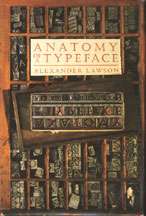Anatomy of a Typeface
 Cover of Anatomy of a Typeface | |
| Author | Alexander Lawson |
|---|---|
| Country | United States |
| Subject | Typography |
| Publisher | David R. Godine, Publisher |
Publication date | 1990 |
| Pages | 428 |
| ISBN | 978-0-87923-333-4 |
| OCLC | 14068305 |
| 686.2/24 19 | |
| LC Class | Z250 .L34 1990 |
Anatomy of a Typeface is a book on typefaces written by Alexander Lawson.[1] The book is notable for devoting entire chapters to the development and uses of individual or small groupings of typefaces. Beyond Anatomy of a Typeface Lawson has considered and discussed the classification of types. Within Anatomy, Lawson arranges the typefaces by classification. In his preface, Lawson qualifies his classification: "After using this system in the teaching of typography over a thirty-year period, I know that it is reasonably effective in the initial study of printing types. I am not disposed to consider it faultless by any means. A classification system, after all, is simply a tool ... Its primary purpose is to help people become familiar with these forms preparatory to putting them to effective and constructive typographic use."[1]
Following are the thirty-one chapters of Anatomy of a Typeface: the Black-letter Types: Goudy Text and Hammer Uncial; Old Style Types: Cloister Old Style, Centaur, Bembo, Arrighi, Dante, Goudy Old Style, Palatino, Garamond, Galliard, Granjon, Sabon, Janson, Caslon, Baskerville, Bodoni, Bulmer, Bell, Oxford, Caledonia, Cheltenham, and Bookman; Newspaper Types: Times Roman; Twentieth-century Gothics: Franklin Gothic; Square-serif Revival: Clarendon; Humanist Sans-serif Types: Optima; Geometric Sans-serif Types: Futura; and Script, Cursive, and Decorated Types; Type Making from Punch to Computer.[1]
The third printing of Anatomy appeared in 2002.